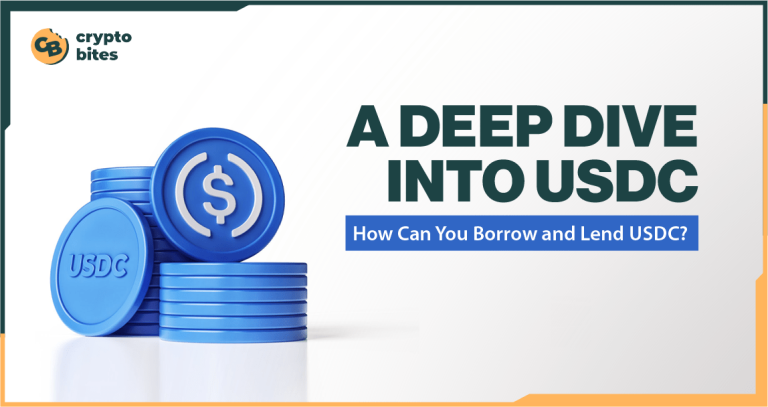
A Deep Dive into USDC: How Can You Borrow and Lend USDC?
Disclaimer: This is not intended as investment advice in any form.
Stablecoins have gained immense trust and popularity in the digital asset realm. These coins are designed to maintain a steady 1:1 value with the US dollar, making them a secure and reliable alternative to conventional currency.
Now, you might be wondering: Can you engage in borrowing and lending with USDC?
Well, lending your stablecoins is a smart way to generate passive income from your crypto holdings. When you lend cryptocurrencies like USDC, which are pegged to the USD, it offers a high degree of predictability for your earnings without the need to worry about the ups and downs of your overall crypto portfolio.
Let’s dive into the world of USDC stablecoins and explore how you can leverage them for lending and earning.
What is USDC?
USDC, short for USD Coin, is a stablecoin that’s pegged to the US dollar and operates on the Ethereum blockchain. Each USDC token has a real US dollar in reserve backing it one to one, which is the key to its dependability. This is quite the opposite of cryptocurrencies like Bitcoin and Ethereum, which are known for their rollercoaster-like price fluctuations.

These dollars are safeguarded and regularly audited to ensure they match the number of USDC tokens in circulation. This provides an extra layer of predictability and safety, making USDC’s value immune to the wild price swings often seen in the crypto market.
The Center Consortium, a collaboration between Circle and Coinbase, issues USDC. These organizations work across various blockchains, which adds to USDC’s versatility. It’s widely used in the DeFi (Decentralized Finance) sector, integrated into both layer 1 and layer 2 projects.
What Type of Stablecoin Is USDC?
USD Coin (USDC) is what we call a “fiat-collateralized stablecoin.”
What makes USDC stand out is its primary goal of keeping its value steady, which is why it’s called a “stablecoin.” In simpler terms, it means that USDC tokens are backed by real-world money, specifically the U.S. dollar or euro.
How Does USDC Work?
Now, you might be curious about how USDC maintains this 1:1 peg with the US dollar. It’s pretty straightforward.
When you buy a USDC with your fiat currency, the equivalent amount of fiat is held in reserve, and a new USDC token is minted. If you ever decide to exchange your USDC for fiat currency, the USDC is essentially “burned” (rendered unusable), while the equivalent fiat is sent back to your bank account.
USDC is versatile and not limited to just the Ethereum network. It’s also compatible with several other blockchains, including Ethereum, Algorand, Solana, Stellar, and TRON.
The token standard used for USDC on the Ethereum network is ERC-20, which is the same standard used by other stablecoins like Tether’s USDT.
What is a USDC Loan?
USDC lending is a straightforward process where you deposit your USDC holdings onto a lending platform. Once you’ve done that, you can start earning additional cryptocurrencies without having to actively manage your investment.
If you need instant liquidity and don’t want to sell your crypto assets, you can opt for an instant USDC loan. Essentially, you’re using your Bitcoin, Ethereum, Monero, or other cryptocurrencies as collateral to borrow USDC.
Here’s how it typically works: you place your crypto on a lending platform, which stores it securely in cold wallets. In return, the platform provides you with an instant USDC loan. The platform’s loan-to-value ratio determines the amount you can borrow. For instance, if the ratio is 25% and you deposit Bitcoin valued at $1000, you’d receive $250 in USDC.
Many decentralized exchanges offer options to lend and borrow USDC. Prominent decentralized platforms like Aave, Compound, MakerDAO, and Coinrabbit facilitate these lending transactions for the stablecoin. They sweeten the deal by offering interest rates, enticing users to lend their USDC and thus contributing to the overall health of the ecosystem.
The beauty of USDC lending is that you not only earn interest through DeFi lending protocols but also support the ecosystem. These platforms assure the safe storage of your assets by keeping deposited USDC in cold wallets.
For instance, Coinrabbit, a lending platform, offers an 8% annual percentage yield (APY) on your USDC holdings with a minimum lending amount of 100 USD coins. The predictability of the USD coin in a volatile industry makes lending these assets an attractive option for generating predictable passive income. This is in stark contrast to other cryptocurrencies that lack the stable value characteristic of a stablecoin, making them less reliable for assured returns.
How Can You Borrow and Lend USDC?
USDC lending can be achieved in two main ways: CeFi (Centralized Finance) and DeFi (Decentralized Finance) methods. For most users, the CeFi route is the more popular choice due to its simplicity.
On the CeFi route, you essentially allow a centralized provider to tap into your USDC holdings. They, in turn, lend these funds to others, handling most of the lending process internally. The trade-off is that you won’t receive the full interest generated by your USDC.
Now, for those looking to engage in USDC lending, it’s all happening on the Ethereum blockchain. But fear not, the process is quite straightforward, especially from the user’s perspective.
To lend your USDC to someone, you simply need to connect your wallet to an existing decentralized exchange (DEX), such as Coinbase or a similar platform. These exchanges come with the necessary code under the hood to enable you to swap coins, earn rewards, and lend tokens.
CeFi USDC Lending
When it comes to lending your crypto assets to borrowers, CeFi (Centralized Finance) USDC lending usually offers the smoother route. This is because a centralized service provider takes care of most of the nitty-gritty details behind the scenes on your behalf.
In the world of CeFi, you can actually borrow money by using your crypto holdings as collateral. It’s the flip side of lending. The interest that borrowers pay for obtaining these funds is what generates the income that you, as a crypto holder, might receive through CeFi.
One of the key benefits of CeFi loans is their simplicity. They’re often far less complicated than traditional bank loans and usually require only minimal documentation. To put things into perspective, residents in the United States can borrow up to $100,000 through Coinbase without having to go through a credit check.
DeFi USDC Lending
You don’t have to rely on centralized exchanges to lend out your USDC tokens; there’s another route through DeFi (Decentralized Finance) crypto exchanges, also known as DEXs.
DeFi lending, short for decentralized finance lending, operates similarly to traditional banking loans but with a twist. Instead of banks, it’s powered by P2P decentralized applications (DApps). These DeFi lending platforms facilitate the borrowing and lending of funds, allowing crypto holders to earn substantial income.
The process of DeFi lending is refreshingly simple. It’s all about providing crypto loans without the need for trust in a centralized intermediary. Users can easily lock up their crypto assets on a DeFi lending platform, sidestepping traditional intermediaries. Borrowers can directly access loans from this decentralized platform using peer-to-peer lending.
What’s more, the DeFi lending protocol benefits lenders by allowing them to earn interest on their crypto assets. Anyone can lend their assets to others and accrue interest on those loans. Similar to how traditional banks operate, DeFi lending relies on lending pools where users contribute their assets, ensuring quick distribution among borrowers through the magic of smart contracts.
Why Should You Lend USDC?
Lending your stablecoins is a smart move in the world of crypto, primarily because it opens up the door to passive income. The process is straightforward, and once you’ve located a reliable platform, it becomes an efficient way to generate earnings from your stored assets.
What makes this approach particularly attractive is that it comes with relatively low risk. When you compare it to other methods like staking, which can be riskier due to potential market fluctuations, lending stablecoins stands out as a pretty secure practice. Moreover, lending doesn’t impact your deposits even when the crypto market is going through its characteristic ups and downs.
Why Take a USDC Loan?
Getting an instant USDC loan can be a smart move in the crypto world. The cool part is that you can still benefit from any price increases in the crypto you’ve used as collateral.
Here’s how it works: when you’re ready to pay back your loan, you’ll need to return the exact amount of your collateral, minus the interest (typically around 10% annually). This means that if your crypto assets are on an upward trend, you won’t lose out on their value. In fact, you might even see some gains.
Now, if you decide to reinvest the USDC you’ve borrowed into other rapidly growing assets, you can potentially increase your profits even more. It’s a dynamic way to make your crypto work for you.
For instance, let’s take CoinRabbit, which offers an Annual Percentage Rate (APR) of 10%. If you decide to borrow for, say, half a year, the cost will be just 5% of your collateral. The cool part is that you don’t need to worry about monthly payments. The entire interest will be charged at the end of the loan period, and you have the flexibility to repay your loan whenever you see fit.
The Popularity of USDC Lending
USD Coin (USDC) has become a standout asset for borrowing and lending in the world of DeFi.
USDC is no ordinary cryptocurrency. It’s a regulated, fully reserved digital dollar stablecoin, which means every USDC token you hold can be exchanged for one US dollar. It even undergoes monthly third-party audits to prove it has those dollars in reserve.
This level of transparency is rare, and combined with the stablecoin’s robust ecosystem, it makes it a top choice for professional crypto investors.
One of the big advantages of USDC is its price stability. This stability allows investors seeking yields (returns) to confidently “lock in” their Annual Percentage Yield (APY) with a fair degree of certainty because the price swings of the underlying asset won’t mess with their absolute returns.
However, when you deposit a volatile crypto asset, like Ethereum (ETH) or Basic Attention Token (BAT), into a yield-generating protocol, the returns you get are often more influenced by the asset’s price movements than the yield it offers. If the asset’s price takes a dive greater than the yield it generates, you could end up with a loss.
But with a stablecoin like USDC, you can be confident that you’ll earn the specified yield from the protocol without being concerned about market risks.
USDC is also a widely traded asset on various crypto exchanges. In fact, most leading crypto platforms support USDC trading, making it incredibly accessible for DeFi investors.
Now, if you’re an Ethereum user, you’ll be pleased to know that any wallet supporting ERC-20 tokens can hold USDC. This makes it a breeze for Ethereum users to deposit the digital dollar stablecoin into Ethereum-based lending DApps.
In fact, USDC’s success is evident as it surpassed the $2 billion issuance milestone on September 13, 2020, making it one of the top 15 largest cryptocurrencies by market capitalization.
Earning Yield on USDC
Right now, the top three platforms generating the most yield, based on the amount of US dollars invested, are Uniswap, Aave, and Curve Finance.
Generating yield is the main reason why many savvy crypto investors are diving into DeFi. Unlike traditional markets where interest rates are historically low, DeFi allows you to earn significant returns by putting your crypto assets into decentralized lending or automated market (AMMs) protocols.
Aave operates like a decentralized money market. It allows crypto holders to both borrow and lend in a decentralized way.
Uniswap, on the other hand, is a decentralized exchange protocol where you can deposit USDC along with another Ethereum-based asset into a trading pool (a pair of assets). By doing this, you contribute liquidity to the trading pool and earn trading fees as a reward.
Curve Finance functions similarly to Uniswap, but it’s mainly focused on stablecoins. This makes it a favorite among USDC holders hungry for yield. When you deposit USDC into a Curve Finance trading pool, you not only earn a portion of the trading fees (around 0.04%), but you also receive additional yield in the form of CRV tokens, distributed based on the amount of funds you provide.
Risks of USDC
First, let’s talk about counterparty risk.
While it’s not very likely, there’s always a small chance that the USD held in reserve to back USDC could face insolvency. In this case, it’s not so much the USDC itself that’s at risk, but rather the entity issuing it, which, in this case, is Circle. If Circle were to encounter financial difficulties or fail to meet its obligations, it could impact the stability of USDC.
The crypto industry is continually evolving, and regulation remains a key issue. Changes in regulatory frameworks can have ripple effects throughout the cryptocurrency sector, including stablecoins like USDC. Keep in mind that USDC isn’t immune to regulatory shifts, and it’s vital to monitor developments in this space.
While USDC operates on a secure blockchain, there’s always the potential for vulnerabilities in the smart contract code. Smart contracts are the backbone of many DeFi operations, and any flaws in these contracts could lead to unexpected issues.
Final Words
USDC, despite the risks we’ve discussed, remains one of the most stable digital assets out there. That’s why it’s a fantastic choice for lending, allowing you to earn some passive income.
The digital asset landscape is constantly changing, but USDC’s peg to the US dollar offers a rare level of stability in the crypto industry. This stability is something you can leverage by lending your USDC holdings. In a world where prices can swing wildly, having a crypto asset that remains steadfastly tied to a stable fiat currency provides a unique advantage for those seeking to earn from their holdings.




